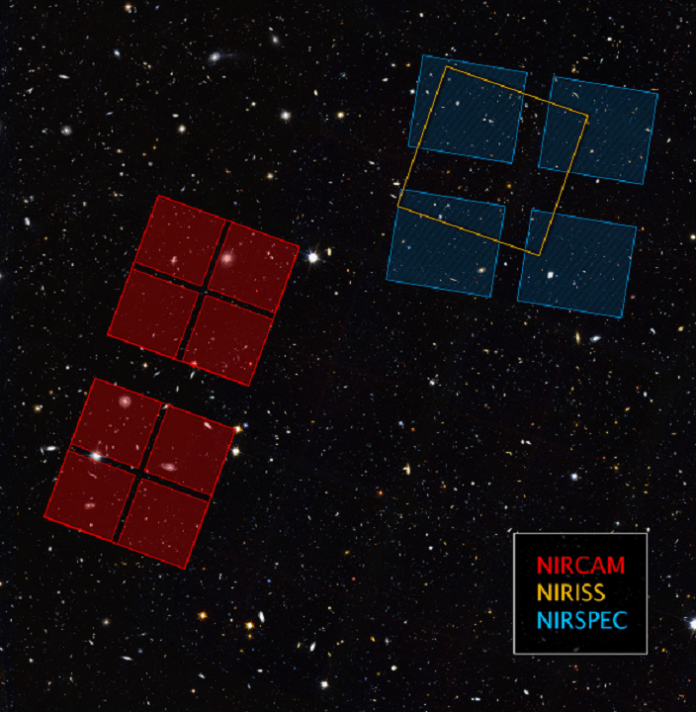Telescópio espacial James Webb (JWST), espaço observatory designed to conduct infrared astronomy and launched successfully on 25 December 2021 will enable two research teams to study earliest galaxies in the universo. The research teams will use JWSTName’s powerful instruments (NIRISS, NIRCam and NIRSpec) to capture and characterize some of the earliest galaxies.
The Next Generation Deep Extragalactic Exploratory Public (NGDEEP) Survey will target Hubble Ultra Deep Field by pointing telescope’s Near-Infrared Imager and Slitless Spectrograph (NIRISS) on the primary Hubble Ultra Deep Field and Near-Infrared Camera (NIRCam) on the parallel field. The two instruments NIRISS and NIRCam will capture infrared light (redshifted due to expansion of universo). The data will be released immediately to benefit the researchers.
NGDEEP team will also identify metal elements in the early galaxies especially in smaller and dimmer ones that haven’t yet been thoroughly studied so far. Study of metal contents of galaxies is standard way to trace evolution across cosmic time. There were only hydrogen and helium in the beginning of the universo. New elements were formed by successive generations of estrelas. Studying metal contents of galaxies will help to plot out precisely when various elements existed and update models that project how galaxies evolved in the early universo.
The other research team will examine the primary Hubble Ultra Deep Field using the microshutter array within the telescope’s Near-Infrared Spectrograph (NIRSpec). This will provide first large sample of earliest galaxies that existed in the early universo enabling researchers to understand them in detail.
The story of study of universo primitivo began in 1995 with the decision to focus Hubble Espaço Telescope (HST) on nothing in the hitherto unexplored field in the sky. Hubble captured about 3000 images of galaxies at different stages of stellar evolution. Better known as Hubble Deep Field, these images were first pictures of early galaxies and revolutionised the field of astronomy.
As a successor of Hubble espaço telescope (HST), Telescópio espacial James Webb (JWST) is carrying forward the Hubble legado do telescópio na área de estudo dos primeiros universo. Webb telescope aims to search for light from the first estrelas and galaxies that formed in the Universo after the Big Bang to study the formation and evolution of galaxies, to understand the formation of estrelas e planetário systems and to study planetário systems and the origins of life.
o início universo in the first several hundred million years after the big bang was a very different place. It was semi-opaque. This is when the first galaxies in the universo were beginning to form. Many distant galaxies have been spotted by the telescopes but none earlier than 400 million years after the big bang. What were galaxies that existed even earlier like? The above mentioned, two research teams will answer just this by revealing details of the earliest chapters of galáxia evolução.
***
Fontes:
- NASA 2022. Webb da NASA para descobrir riquezas do universo primitivo, publicado em 22 de junho de 2022. Disponível online em https://webbtelescope.org/contents/news-releases/2022/news-2022-015.html Acessado em 23 de junho de 2022.
- Prasad U., 2021. Telescópio Espacial James Webb (JWST): O Primeiro Observatório Espacial Dedicado ao Estudo do Universo Primitivo. Europeu Científico. Publicado em 6 de novembro de 2021. Disponível online em http://scientificeuropean.co.uk/sciences/space/james-webb-space-telescope-jwst-the-first-space-observatory-dedicated-to-the-study-of-early-universe/
***






































